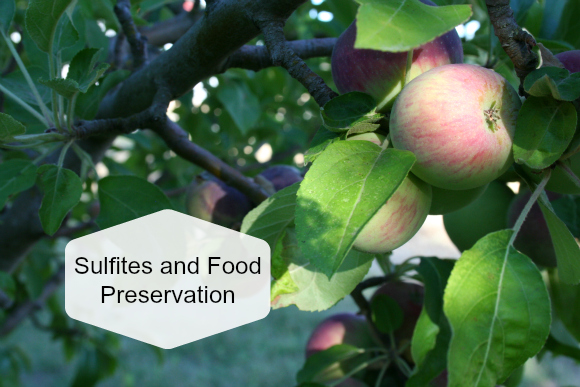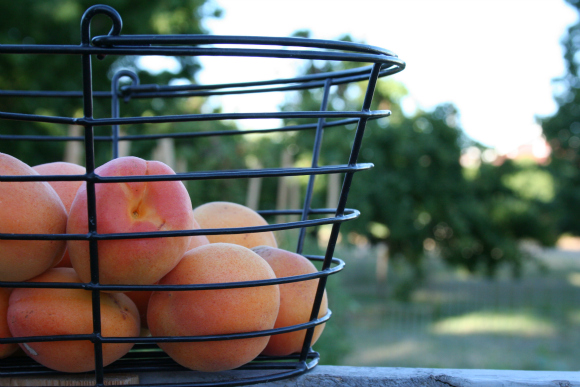
Here for Simple Lives Thursday? We will no longer be hosting this weekly blog hop. I’m sorry about this, but I know you’ll find other reasons to visit regularly, whether Thursday or any day. 🙂 And… you can still do SLT with Diana at My Humble Kitchen, or with the new host, my friend Millie at Homespun Oasis (here’s today’s SLT post). –Wardee
When I first broke open the box of my precious dehydrator, I found a manila envelope labeled “sodium bisulfite”. I was completely new to the world of dehydrating and extremely paranoid due to severe food allergies in the home, so it took me about 7 seconds to toss it aside. I momentarily wondered — what exactly did that envelope hold? Was it that famous ‘sulphur’ additive known for causing food allergies? It didn’t matter. I was on a jerky mission and figured I would come back to that later.
Fast forward two years and I am finally moving beyond yogurt and jerky in the dehydrator. That little packet is still around, and I’m purging. Before tossing it, I decided to do a little digging and find out what exactly is in that envelope.
What was in the envelope?
Sodium bisulfite is one of several sulfur based chemicals commonly known as ‘sulfites’. Other sulfite names you might find on an ingredient list include potassium bisulfite, potassium metabisulfite, sodium metabisulfite, sodium sulfite, or sulfur dioxide. Their fungicide and bleaching properties make them very versatile in industry, so these sulfur-based chemicals are used in everything from water treatment, to textile drying, to jewelry making, to film preparation.
Sulfites are also used as a food preservative, both commercially and in the home. In commercial dehydration this may mean using a sulfur gas to fumigate them. At home it usually means soaking the produce in a sodium bisulfite and water mix before dehydrating.
Are there benefits to using sulfites in home dehydration?
Sulfites are primarily used to create a pretty product by stopping the natural browning process of produce. Apricots stay that plump orange, and those golden grapes don’t turn ugly. Sulfites also kill bacteria and fungus, giving foods a longer shelf life. And they slow the natural breakdown of vitamin C and A, lending to the claim that sulfites ‘preserve nutrients’. All very helpful.

But wait. There’s more.
Sodium bisulfite comes with the recommendation that you wear gloves, rinse the produce afterward, and do your soaking in a well-ventilated area. When you add sodium bisulfite to water, it breaks down into a gas that can be toxic when inhaled. Yikes.
As for preserving nutrients, sulfites destroy vitamin B1 (thiamin). The FDA weighs in on this by saying sulfites are not allowed on any food containing vitamin B1 (thiamin). And due to the estimate that 1 in 100 people are sulfite sensitive, the FDA has made it illegal to use sulfites on foods sold raw. Except potatoes. They get an exception. (Because the food industry says there is no alternative to keeping their french fries from looking brown, and it would ruin their business.)
The FDA lists sulfites on it’s generally recognized as safe list, where it also says “the biological effects of sulfiting agents are still incompletely understood”. It’s not mentioned that industrial sulfites are linked to neurological, gastrointestinal, and respiratory problems. Trace amounts of sulfites have been known to cause hives, vomiting, wheezing, and anaphylaxis. Asthmatics are declared to have a higher risk of reaction.
And it gets better. It is suspected that some reactions are due to sulfite-containing foods reacting with acid in the stomach, and producing sulfur dioxide (that toxic gas). Lovely.
Sulfites stop the browning and further ripening of fruit by blocking the natural enzyme, polyphenol oxidase. While the food industry has done a great job convincing us that a brown fruit is a bad fruit, the reason for this natural process has not been thoroughly studied. Recently it was discovered that this browning process is a defense mechanism with a role in fighting pathogens — a built in bacteria and fungus killer.
One little manila envelope marked sodium bisulfite will no longer be taking up space in my kitchen. For our home, it certainly belongs in the trash.
The produce that goes into my dehydrator doesn’t get much prep, and comes out great. Apricots and persimmons do turn a little brown, but no one seems to mind and it certainly doesn’t affect the taste. If you are concerned about the browning of your home dried produce, you can always enlist the help of a natural lemon juice soak before loading your dehydrator. (You can learn how to do this, along other natural ways of prepping foods for drying, in Wardee’s Dehydrating eCourse.)
What do you think about the use of sulfites to preserve your produce? Do the risks outweigh the benefits for your home?
Sources: What is sodium bisulfite? and USFDA.
We only recommend products and services we wholeheartedly endorse. This post may contain special links through which we earn a small commission if you make a purchase (though your price is the same).


I cleaned raw shrimp that had been sprayed with meatbisulfites as a preservative. With a tiny papercut on my thumb, I ended up with a full-blown allergic reaction on that arm, including blood poisoning above my elbow, redness all up my arm, swelling and throbbing. I used pure essential oils to heal myself, but the experience was eye-opening. Apparently, all sulfites are dangerous.
yowsers! That sounds scary! glad it turned out ok. what essential oils did you find helpful for the reaction?
Eating food with sulfites gives me asthma. I am a careful label reader for it! I can usually tolerate small amounts in red wine. I think it is used by wine producers to rinse the bottles prior to bottling, not as an actual addition to the product.
Wine does contain low levels of naturally occurring sulfites, but organic wine can not have any additional sulfite chemicals added in the process. You might have better luck with those. 🙂
Great posting and very helpful–thank you, Nicole! Glad you mentioned about wine, Elizabeth, for when we have wine it is usually the cheaper Trader Joe’s brand. I will check into this the next time. Martha
I’ve heard that celery juice has natural sulfites, and that you can add to foods, even cutting down the need for so much salt when fermenting. Do you know if this is true?
There are a few foods that do have small amounts of naturally occurring sulfites – beets, spinach, radishes and celery. It is much less common for these natural sulfites to bother people who are sensitive. I had not heard of using celery juice in fermentation! Very interesting! I found information online through a reputable source saying that celery juice would work for a salt free ferment, but would not prevent the veggies from getting mushy.
I am not a very experinced ferminter but have found using celery juce or even finely cut celery very sucessful.
Great taste and indeed not much salt needed. Nellie
So glad you covered this topic. Gracious. It’s amazing what we unknowingly put into our bodies sometimes, no? I rather like some of my dried fruits to have a lemon juice bath prior to dehydrating. It gives them a little kick! 😉 Thanks for this great piece!
I’ve not used anything with sulfites for years. Many years ago I noticed my mouth itched when I ate anything cured with it. Figured that was NOT a good sign! Natural may not be as pretty – but much healthier.
Hi Nichole! Just about the time you posted this information, we realized that my husband’s multiple woes (seasonal allergies, watery / swollen eyes, migraines, asthma) were mostly due to dairy products and… sulfites. I have since then often wondered if they are not one of the causes of the increase in children’s asthma. Like you, I now try to take care of our health with food and herbs. As I sit hear typing I am brewing your cough syrup recipe! Thank you for sharing.
Thank you Nicole, for bringing this to the attention of your readers.
I have been reading many websites, since I discovered I am sulfite allergic.
(I was asthmatic when a child, but now at 70, I am experiencing tightness again and other symptoms. On investigation I found my way to discovering what was actually happening.)
I would just like to share a word of caution, as I see many, including yourself, advocating “lemon juice”.
My personal experience includes sulfite allergy to fresh lemons and oranges!
I also get a swollen tongue, from various products, which indicates the presence of sulfites in what I’ve eaten.
I am still learning, but feeling much better leaving out as many products with sulphites, as possible.
Thanks once again,
Graham.
PS: If like myself any of your readers are in Europe, they will be shocked to know, that regulations on sulphites are still not properly applied in Europe. Since 2016, they have still not laid down specific guidelines, as sometime in 2020 they are to announce them. When and how stringent they will be, we don’t know. Therefore at present, there are a lot of sulphites being used in Europe, and especially in Spain where I live.
Does France use Sulfites?
Thank you.